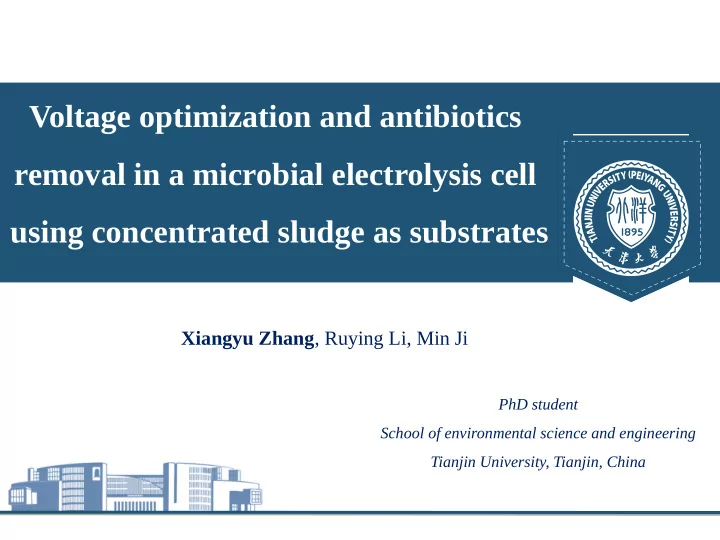

Voltage optimization and antibiotics removal in a microbial electrolysis cell using concentrated sludge as substrates Xiangyu Zhang , Ruying Li, Min Ji PhD student School of environmental science and engineering Tianjin University, Tianjin, China
Introduction Introduction (a) Advantages: Accelerate reaction rate Improve system stability Promote decomposition of refractory organics …… Concentrated sludge (b) Overcome: Slow hydrolysis and acidification rate Methanogenesis substrate restrictions Vulnerable process stability …… CO 2 ) (a. M. Villano, F. Aulenta, C. Ciucci, et al. Bioresource Technology, 2010) (b. G. Zhen, T. Kobayashi, X. Lu, et al. Chemosphere, 2016)
Introduction Introduction MECs treating sludge mainly focused on organic matters removal (COD and VS) and energy recovery ( H 2 and CH 4 ). (a) High concentration residue in sludge Antibiotics removal in MEC treating sludge has been rarely reported. Gradient redox potential and pH, as well as specifjc (b) bioelectrodes niche might be helpful to their degradation. Limited antibiotics removal Efficiencies in traditional AD (a. P. Verlicchi, E. Zambello. Science of the Total Environment, 2015) (b. X. Zhang, R. Li. Bioresource Technology, 2018)
Introduction Introduction Applied voltage Electrochemical performance Microbial distribution Electrochemical performance Microbial distribution Potential Current CV Electrode Suspended Electrode Suspended biofilms microbials biofilms microbials
Experiment Experiment Electrochemical performance Applied voltages: 0 V 0.3V 0.6V 1.0V 1.5V Current Cathode potential Antibiotics removal Tetracycline Fluoroquinolones Tetracycline (TC) Norfloxacin (NOR) Oxytetracycline (OTC) Ciprofloxacin (CIP) Chlortetracycline (CTC) Ofloxacin (OFL) Macrolides Roxithromycin (ROX), Azithromycin (AZI) Dehydrated erythromycin (ERY-H 2 O) Microbials responses Suspended microbial Electrode biofilms Viability Enrichment Activity Visualization Composition Concentrated sludge (4~5%)
Results and Results and Discussion Discussion Average current Peak current Average cathode potential Average anode potential Table 1. Characteristics of raw sludge and initial mixed sludge (mA) (mA) (V) (V) Raw sludge Initial mixed sludge 0.6 V > 1.0 V > 1.5 V > 0.3 V 0 -0.481 -0.479 TS (g/L) 35.56 ± 1.78 34.96 ± 1.90 VS (g/L) 20.24 ± 1.00 18.08 ± 0.42 0.3 V 0.79 1.76 -0.735 -0.450 SCOD (mg/L) 361 ± 20 827 ± 33 0.6 V 2.03 3.87 -0.804 -0.294 pH 6.83 ± 0.03 7.12 ± 0.01 Conductivity (mS/cm) 14.05 ± 0.12 17.57 ± 0.17 1.0 V 1.71 3.67 -0.735 0.235 1.5 V 1.37 3.08 -0.758 0.697 Fig. 1. Current development and cathode potential development during the startup of MECs under different applied voltages.
Results and Results and Discussion Discussion Table 2. The concentration of antibiotics in the initial mixed sludge ERY-H 2 O Antibiotics NOR CIP OFL TC OTC CTC AZI ROX Concentration (μg/kg dry 1534.51 452.81 2894.71 120.12 850.49 15.88 445.33 9.22 10.92 weight) (30.51) (0.54) (37.40) (2.56) (4.63) (0.39) (35.66) (1.61) (0.12) 18-48% 53-78% Fig. 2. Removal efficiencies of antibiotics in MECs under different applied voltages.
Results and Results and Discussion Discussion Fig. 3. Suspended sludge microorganism viability and ATP in different applied voltages MECs and anaerobic digestion (AD).
Results and Results and Discussion Discussion Fig. 4. Unweighted unifrac distance, relative abundance at phylum level and class level of suspended sludge microorganisms in raw sludge (IMS) and different applied voltages MECs.
Results and Results and Discussion Discussion Fig. 5. Cyclic voltammetry (CV) profile of bioanodes under different applied voltages in PBS. Anode Oxidation peak (mA) Maximum oxidation current (mA) 0 3.6 2.42 0.3 V 5.32 3.65 0.6 V 9.39 5.9 1.0 V 9.15 1.5 V 1.37
Results and Results and Discussion Discussion Anode 0.3 V 0.6 V 1.0 V Cathode 0.3 V 0.6 V 1.0 V Fig. 6. Scanning electron micrographs (SEM) of anode and cathode biofilms enriched under different applied voltages.
Results and Results and Discussion Discussion 0.6 V Table 3. Distribution of elements on cathodes under 0.6V and 1.5V Elements 0.6 V (Wt%) 1.5 V (Wt%) C 50.0 ± 0.3 40.6 ± 0.4 O 26.0 ± 0.2 26.8 ± 0.3 F 8.3 ± 0.2 6.6 ± 0.2 P 4.3 ± 0.1 7.8 ± 0.1 K 3.0 ± 0.1 5.8 ± 0.1 Pt 2.3 ± 0.2 2.6 ± 0.3 1.5 V Fe 2.2 ± 0.1 3.2 ± 0.1 Ca 1.6 ± 0.0 3.0 ± 0.1 Al 1.1 ± 0.0 2.6 ± 0.0 Mg 0.6 ± 0.0 0.3 ± 0.0 S 0.6 ± 0.0 0.8 ± 0.0 Fig. 6. SEM-EDS elements analysis of cathodes at 0.6 V and 1.5 V.
Conclusions • The antibiotics removal efficiencies of 18.1-78.4% in MECs at room temperature were comparable to that in mesophilic AD. • Different applied voltages had little effect on the suspended sludge microorganisms viability, activity and composition even up to 1.5V. • Neither electrochemical reaction nor the suspended sludge microorganisms was the driving force for the enhanced removal of antibiotics. Electrodes had bioaugmentation effects on the enhanced removal of antibiotics.
Thanks for your listening! zhangxiangyu@tju.edu.cn
Recommend
More recommend